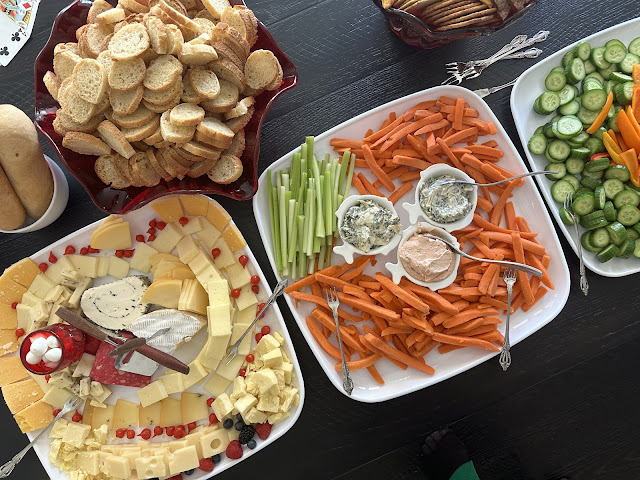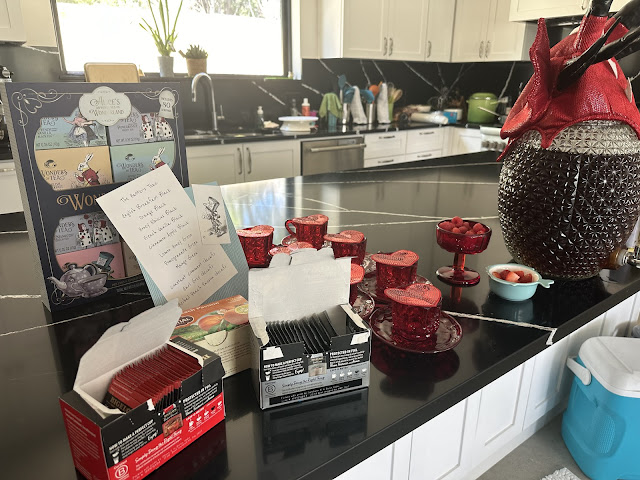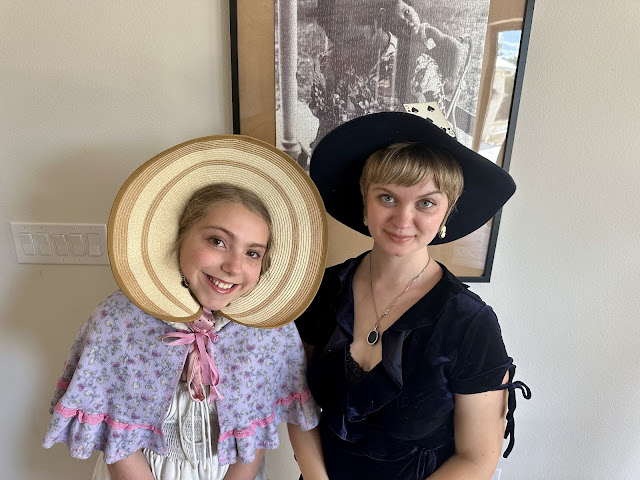Major food allergens are milk, eggs, wheat, tree nuts, peanuts, soybeans, fish, shellfish, and SESAME.
Sesame is new.
If you're doing something for four hours or more, you have to make everything clean.
So throw out your disposable gloves and clean your cutting board and knife, etc.
Here's a quick temperature chart.
145° - whole seafood, beef, pork, veal, lamb, and roasts; eggs that will be served immediately
155° - ground, injected, marinated, or tenderized meats; eggs that will be hot held
165° - chicken, turkey, duck fowl, stuffing made with meat, stuffed pasta, casseroles
Pop Quiz: What's an example of intact meat?
Answer: Anything that isn't ground. With the exception of poultry, these must be cooked to 145°.
Pop Quiz: If you are peeling potatoes for 5 hours, do you need to stop and wash your peeler?
Answer: Yes.
Pop Quiz: What's the new allergy?
Answer: Sesame.
Here's the original post, in case I'm doing this again in 2 years.
--------------------------------------------------------------11 SEP 2021--------------------------------------------------------------
Just in case you don't want to go to
txfoodhandlers.com and pay the $7.95 + $2.05 to get your very own TX Food Handler's Card, but you really want to know what they teach you, I thought I'd summarize the course here.
Chapter 1: The Importance of Food SafetyEvery year in this country, 48 million people get sick, 128K get hospitalized, and 3K people die from foodborne illnesses. So "the importance of food safety" is to NOT make people sick and die.
A "highly susceptible population" refers to young children, the elderly, pregnant women, and people who have illnesses that have weakened their immune systems; this population has a higher risk of contracting foodborne illnesses, so stricter rules regarding food preparation can apply.
The hazards that cause foodborne illnesses are biological, chemical, and physical.
The three most common biological hazards are salmonella, E. coli, and norovirus. Salmonella lives in the intestines, and can come from fruits and vegetables or undercooked eggs and meats. Symptoms include fever, diarrhea, and vomiting. E. coli lives in the intestines as well, and can come from undercooked meats and unpasteurized milk. Symptoms include severe diarrhea and kidney damage.
Norovirus is the most common form of foodborne illness, and it's often called "food poisoning" or the "stomach flu." Symptoms include diarrhea, vomiting, and stomach pain.
If you have have suffered from vomiting, diarrhea, fever and sore throat, or jaundice in the last 24 hours, please don't go to work.
To elaborate, the "Big 6 Illnesses" are:
Nontyphoidal Salmonella
Salmonella Typhi
Shigella
Shiga Toxin Producing E. Coli
Hepatitis A
Norovirus
Chemical hazards and physical hazards really shouldn't happen, but they certainly will if you add pesticides, soaps, sanitizers, fingernails, and metal screws to your food.
The most common food allergies are milk, soy, eggs, wheat, nuts, peanuts, fish, and shellfish. In this country, these allergies send someone to the ER every 3 minutes. Some food allergy reactions include tingling sensations, hives, swelling of the mouth or throat, difficulty breathing, and loss of consciousness. Please tell a P.I.C., or a "Person In Charge" if a person in your facility has lost consciousness. That way, we can keep each other safe.
And if you are the P.I.C., please tell yourself about what has happened.
Pop Quiz: Which of the three common biological hazards cause sever diarrhea?
Answer: Tricky! Severe diarrhea goes along with kidney damage, and those are associated with E. coli.
Pop Quiz: Why the hell did the course start talking about jaundice?
Answer: I really don't know, but I agree that you should stay home from work if you are suddenly the wrong color.
Chapter 2: Health & Hygiene
70% of all foodborne illnesses are caused by improper hand washing. (But really, they're probably caused by a lack of hand washing, right?) In addition to washing your hands, trim your fingernails, keep your hair restrained, wear proper clothing, and always cover cuts and burns.
Wash your hands after using the restroom. Then wash again when you get to the kitchen, but not in the kitchen sink - only in the hand washing sink that's in the kitchen. This is called a "double hand washing," and it's super cool.
Washing your hands requires five steps. Wash your hands without soap. Wash your hands with soap for 20 seconds. Continue washing your hands with soap to get into all the places on your hands that you couldn't find in the first 20 seconds. Wash your hands without soap. Dry your hands with a paper towel, but not a reusable towel. Towels are not appropriate for drying hands or dishes.
Wash your hands before you begin food preparation; when you have touched your face or nose or any other human body part; after you have sneezed, coughed, or blown your nose; after handling raw meat, fish, or poultry; after handling dirty dishes or garbage; after handling animals, money, or chemicals; after taking a break; after eating; and after smoking. Also wash your hands "when you have been contaminated by exposure to potential germs."
After you have washed your hands, use barriers to protect food, such as gloves, utensils, and tongs. Wash your hands after removing gloves.
Jewelry and personal items such as your phone or purse should be kept away from you in a designated employee area. Simple rings, such as wedding bands, may be worn under disposable gloves.
If you'd like a recipe for sanitizer, mix 1/3 C bleach with a gallon of water. You can also use an alcohol solution that is 70% alcohol or higher.
Pop Quiz: Can you ever not be washing your hands?
Answer: Germs are everywhere, so potential germs might as well live in the fourth and fifth dimensions. So you can take a break from washing your hands if your bakery is in the sixth dimension, but then wash your hands, because we always wash our hands after taking a break.
Pop Quiz: Are towels appropriate?
Answer: Towels are not appropriate.
Pop Quiz: I don't have disposable gloves. Where should I put my wedding band?
Answer: In a designated employee area very far away from you.
Chapter 3: Temperature Control
Keep cold foods at or below 41° F (cold holding) and hot foods at or above 135° F (hot holding).
In fact, 42-134° F is called THE DANGER ZONE.
Foods that are very temperature-sensitive are meat, fish, poultry, seafood, eggs, and milk. Other foods that must also avoid the danger zone are rice, beans, pasta, potatoes, cooked vegetables, tofu, sprouts, melons, and garlic and herbs in oil. If temperature-sensitive foods have been left out for more than 4 hours, throw them away.
That's a lot of garlic and herbs in oil that ought to be thrown away.
Seafood, pork, and beef steaks must be cooked to 145 for 15 seconds, roasts to 145 for 4 minutes, ground meat to 155 for 17 seconds, and poultry to 165 for 1 second. Eggs for immediate service must be cooked to 145 for 15 seconds. Eggs for later service, however, must be cooked to 155 for 17 seconds and then held at 135. Memorize that, but only in your short-term memory if you're like me and just trying to bake a cupcake.
Thawing Frozen Foods
The safest way to thaw frozen foods is to store them in a refrigerator. It is also acceptable to place frozen foods under running water that is 70 or colder. Don't try to heat frozen foods up quickly, as this can lead to some areas being suspended in the danger zone.
Reheating Cold Foods
It is always important to move through the danger zone as quickly as possible. Food must be reheated to 165 for 15 seconds within 2 hours before being put onto a preheated steam table held at 135.
Cooling Down Hot Foods
Again, the goal is to move through the danger zone as quickly as possible. To cool down hot foods quickly, cut the food into smaller pieces and place in shallow pans. Food can either be placed in the refrigerator or stored in containers that are placed in an ice bath. Food must cool to 70° within 2 hours and cool from 70° to 41° within the next 4 hours for a total cooling period of 6 hours or less. These specifics are known as the "time and temperature method."
Pop Quiz: If temperature sensitive foods have been left out for 3 hours and 59 minutes, are they safe to consume?
Answer: Yes. They are also safe to consume at 4 hours. But not one millisecond after that.
Chapter 4: Avoiding Cross-Contamination
Cross-contamination is caused by the spread of bacteria from one food or surface to another. Never place cooked food on a surface that has previously held raw meat, poultry, seafood, or eggs. Always keep vegetables and meats separate, use separate cutting boards for each, and always wash your hands after handling raw meat.
Store ready-to-eat food on the top shelf, then raw fish, then raw meat, then raw ground meat, and then raw poultry. In other words, rank foods by their minimum internal temperature requirements, with the highest temperature at the bottom.
Similarly, store cleaning chemicals in a non-food designated area on the bottom shelf.
To wash dishes, simply turn to your handy three sink set-up. Wash with hot soapy water in the first sink, rinse with clean hot water in the second sink, and sanitize in warm water and an approved sanitizer in the third.
Store bowls upside down and utensils and dishes at least 6 inches off the ground.
And remember, prevention is the most effective way to keep your kitchen pest-free.
Pop Quiz: Can you wash dishes by hand if you don't have three sinks?
Answer: No.
Pop Quiz: What should you do if you have pests?
Answer: And remember, prevention is the most effective way to keep your kitchen pest-free.
Chapter 5: Safe Food Sources (Optional Content)
Meat, poultry, and dairy must be inspected by the USDA or the Department of Agriculture, and food establishments may only serve food from a source that is approved by the local health department.
Before accepting food deliveries, food must be inspected by a designated person at the food establishment. This person inspects for mold or extreme bruising on fruits and vegetables; signs of spoiling on meat; opened, rusty, or severely damaged canned goods; and danger zone temperatures.
Pop Quiz: Does this matter to a home baker?
Answer: No. That's why it was optional.
Chapter 6: Food Worker's Top 10
A better name for this chapter would be "Review."
Only work if you're healthy.
Wash hands thoroughly and often.
Don't touch ready-to-eat foods with bare hands.
Keep food at or below 41°, or at or above 135°.
Cook foods to proper temperatures before serving.
Cool hot food as quickly as possible, and cool from 135 to 41 within 6 hours.
Keep raw meat away from other foods.
Always follow these steps for cleaning: wash, rinse, sanitize, air dry.
Keep food prep areas clean and sanitized.
Always ask your PIC questions you may have regarding food safety.
Pop Quiz: What would be a better name for this chapter?
Answer: "Review."
Not to brag, but I passed with honors. And now you can, too.


































